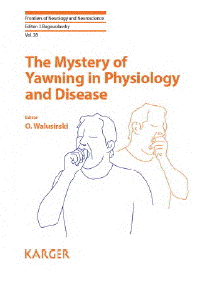Introduction : Blinking is a
behaviour which is easy, to observe in most
vertebrates and in all mammals, and which occurs
spontaneously in the absence of any identifiable
stimulus. Blinking is centrally correlated with
cognitive and visual functions and spontancous
blinking rate (SBR) varies with the activity of
the subject (Stern et al., 1984). Yawning is a
reflex which, although not yet completely
understood, is known to be physiologically
induced by hunger, boredom, and imitation.
However, its pathological meaning has been
acknowledged since ancient times. At least one
neurobiological step of these two behaviours is
dopamine-dependent. Variations in SBR (Karson,
1983; Karson et al., 1984) and yawning (Heusner,
1946) have been observed in various pathologies
mainly related to dopaminergic systern
dysfunction: Parkinson's disease. progressive
supranuclear palsy (PSP), Huntington disease,
schizophrenia, Gilles de la Tourelle syndrome.
Apomorphine, a dopaminergic reference agonist,
induces yawning (Holmgren & Urba-Holmgren,
1980...) and increases SBR (Karson. 1983) in
animais. ThuS, dopaminergic systems may modulate
blink rate and yawning.
The aim of our study was 1) to determine if
low doses of apomorphine devoid of emetic
properties could induce yawning and increase SBR
healthy volunteers, and 2) to study
doses-ranging in order to determine if yawing
and SBR can serve as assessment factors of the
central nervous system (CNS) dopaminergic
receptors in humans.
[...]
Discussion : Various studies suggest
that CNS doparninergic systems play a major role
in SBRand yawning. In rats, apomorphine induces
ptosis (Puech et al, 1974). In monkeys,
apomorphine increases SBR (Casey et al 1980;
Karson et al. 1981 ) as does bromocriptine
(Karson. 1983). Treatment with the dopamine
D2-receptor blocker, sulpiride, antagonizes
apomorphine-induced SBR (Karson, 1983).
Dopamine, which does not penetrate the
blood-brain barrier, does not change SBR. Thus
SBR is related to CNS dopamine activity (Karson,
1983).
Apomorphine induces yawming as well
(Holmgren
& Urba-Holmgren, 1980; Mogilnicka
& Klimek 1977, ...) Apomorphine-induced
yawning is antagonized by both typical (Protais
1983) and atypical neuroleptics (Dubuc 1982),
but not by domperidone, a peripheric dopamine
recepor blocker (Corsini 1981 ). Thus, yawning
is related to the activatrion of CNS
dopaminergic receptors.
In Parkinsonism (Hall. 1945 Karson 1984) as
well as in PSP (Karson et al., I984), SBR is
low. This reduction is related to the severity
of the clinical signs. Moreover there is a
difference between non-dyskinctic and dyskinetic
patient. SBR being higher in the lattter
(Karson. 1983; Karson 1982). Yawning seems to
be infrequent in Parkinson patients.
In Hungtington's disease, SBR is
greater in some patients. Unfortunately, this
study deals wiyh patients who have been
previously treated with neuroleptics (Karson et
al., 1984). In this disease, yawning seems to be
frequent (Boudouresques et al.. 1965),
In schizophrenia, SBR seems to
increase (Karson 1983: Karson 1986) Although
there were no details, these studies probably
dealt with patients with positive symptoms. In
the last two studies, patients had been treated
previously.
Few pharmacological studies have been carried
out on man. In Parkinsonism, the reduction of
SBR is corrected by levodopa administration
(Karson 1982). In Schizophrenia, the higher SBR
is modified by neuroleptics (Karson 1982; Mieser
1984). Methylphenidate a dopamine reuptake
inhibitor, increases SBR in schizophrenia, and
this response can be considered as a prediction
of relapse after the withdrawal of neuroleptics
(Liberman 1987)
In healthy volonteers, low doses of
apomorphine (less than 5µg/kg) were shown
to induce yawning (Blin
1988), higher doses do not lead to the same
effect probably on account of mutually exclusive
reaction to the doses (vomiting) (Lal 1989).
Physiological data on sex or chronobiological
variations indicate (Anias
1984) that these seem able to modulate the
apomorphine-induced yawning, and therefore
require further experiment.
The pharmacological mechanism underlying
yawning and SBR remains unexplained?. according
to recent studies on yawning, it seems that more
than being simply related to isolated
stimulation of pre or post synaptic dopamine D2
receptors, apomorphine-induced yawning is
related to the combined action of the dopamine
D1- and D2 receptors (Aubin
& Garma 1988).
In our study, apomorphine (0.5. 1 and 2
µg / kg) induced yawning and increased SBR
in healthy volunteers. In the 20-30 min interva,
there was a significant correlation between
individual SBR differences and individual number
ofyawns. Thus, in our study, this result
suggests a parallel individual evolution between
the two behaviours. These behavioural effects
were not dose-related. Moreover at lower doses
there is a danger that the pharmacological
response would be concealed by behavioural
variability, triggered by non-specific
physiological factors.
In conclusion, low doses of
apomorphine, a reference dopaminergic agonist
increased yawning and SBR in healthy volunteers.
This parallel yawning and SBR behaviour suggests
a similar pharmalogical mechanism. Our study
suggests, that SBR and yawning are valuable
clinical signs and may be therefore of use in
the evaluation of central dopaminergic pathways
in man. Further studies would be required to
show differences response in different
individualls dopaminergic tone, in order to
validate this procedure for clinical use.


